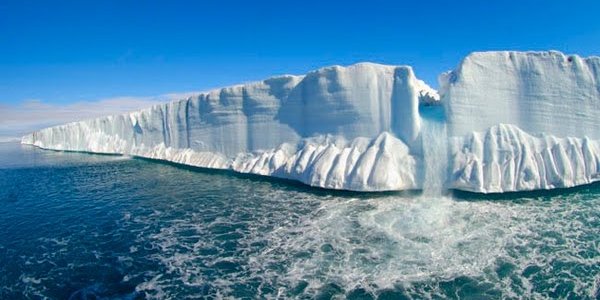Hello, people of steem, and welcome to my page.
There's a news story that came out today about how the lakes that form in the summer on Greenland's ice sheet are helping to speed up the loss of ice from the mass of the ice sheet. I thought it was worth writing about, because the ice loss on the above sea level Greenland ice sheet is a major contributor to rising sea levels, and may also be contributing to thinner ice in the Arctic sea.

First the thinner ice. Fresh water freezes at about 32 degrees F, while sea water, because of it's saline content, freezes at about 0 degrees F. With large amounts of fresh water and icebergs entering the water around Greenland, it changes the salinity of the local surface water enough to affect the freezing temperature of the surface. The less dense fresh water sits at the surface and freezes sooner, but it provides a bit of insulation to the sea water under the ice, slowing down the freezing process enough that the sea ice doesn't get as thick. Because of this, the sea ice melts faster in the spring as the temperatures rise above freezing in the Arctic during the daylight hours.
In the summer, lots of lakes form on the surface of the Greenland ice sheet as the summer sun melts the surface ice. These lakes can last for several weeks to several months. These lakes tend to drain rapidly, usually in a few days or less, down through cracks that develop in the ice. The water generally makes it's way down through the cracks to the bottom of the ice, carrying a certain amount of heat with it to the bottom of the ice. From there, it spreads out under the ice, basically lubricating the movement of the glaciers toward the sea and thus speeding up the movement by a measurable amount.
The scientists recently discovered through observation that these lakes tend to drain in groups in what they describe as a cascading event. When one lake drains through the ice, it's movement causes more cracks which causes more lakes to drain. This cascading event can cause sudden movements in the ice sheet that can cause most of the lakes in one area to drain in a short period of time, a matter of just days. This also can cause a chain reaction in other areas, causing more lakes to drain suddenly. This large influx of water and relative heat to the bottom of the ice sheet causes more instability of the ice sheet, causing more ice loss to the sea.
According to the research, 25 years ago, the Greenland ice sheet was stable, and now it loses millions of tons a day to the sea. This above sea level ice loss into the sea is contributing to rising sea levels, and all of the problems that that entails. Rising sea levels, so far small, but measurable, are already contributing to the damage caused by storm surges and beach erosion. Estimates differ among researchers about how fast sea levels are rising, but the amount of sea level rise is based on the amount of above sea level ice that may be lost into the sea in the next 50 years. Those numbers are not good news for anyone living in coastal areas.
For more information on this subject, you can read this article.
https://www.sciencedaily.com/releases/2018/03/180314092305.htm

Thank you for reading my post! I hope you found this information interesting, and perhaps even useful.
If you would like to read more posts like this, and about other subjects, please consider following my page.
My last post related to this subject was 2 weeks ago, you can read it by following this link.
https://steemit.com/news/@preppin-for-real/it-s-getting-warm-in-the-arctic
